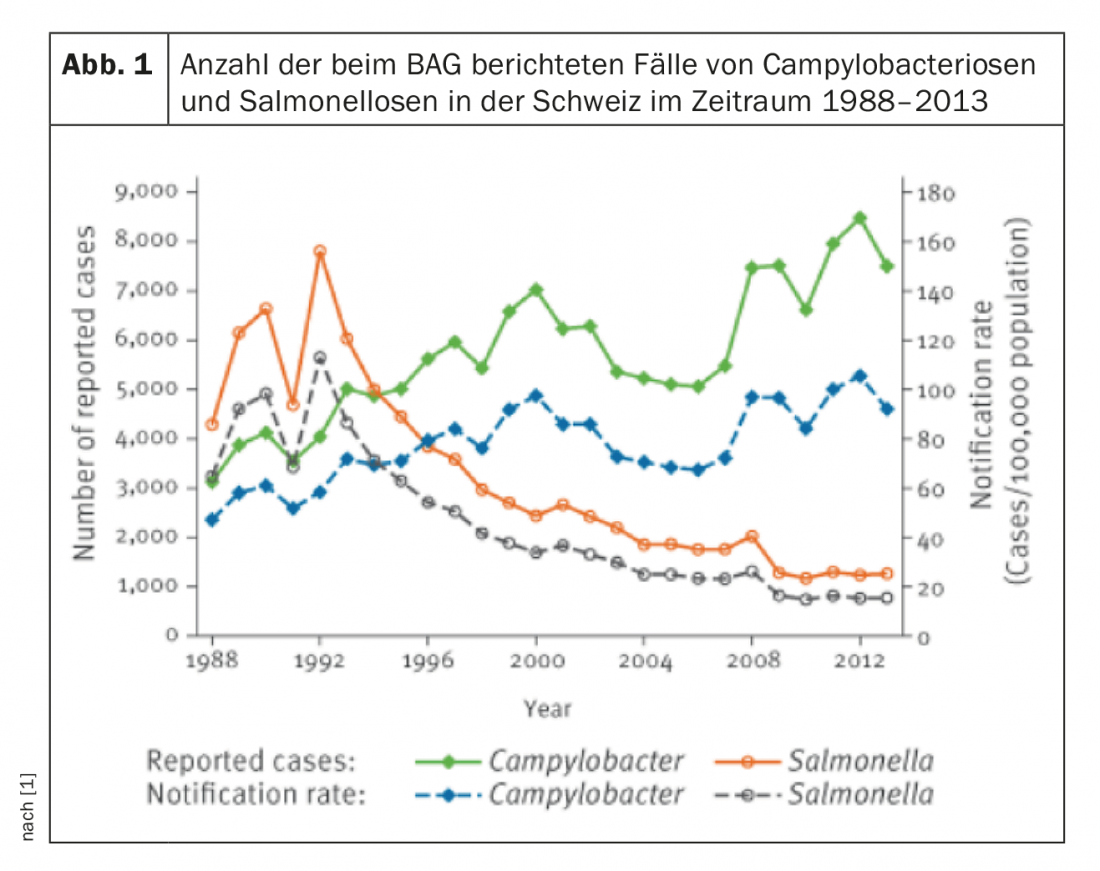The number of cases of salmonella infections in Switzerland has been reduced over the last few years, but not for the more dangerous campylobacter. What is the current situation regarding risky microorganisms in food?
(mp) The following three hazard risks are associated with the consumption of food contaminated by microorganisms: Intoxications (e.g. by Clostridium), infections (e.g. by Listeria, Campylobacter) and (toxi-) infections (e.g. by Salmonella, Shigella). Salmonella (in poultry, eggs, unpasteurized milk, meat products) and Campylobacter (especially in poultry) are the most common foodborne pathogens in Switzerland. Compared to Salmonella, the infectious dose of Campylobacter is very low and incidence rates have increased in recent years (Fig. 1) [1]. In this context, the Federal Food Safety and Veterinary Office (FSVO) has issued safety instructions for the preparation of raw meat (e.g. fondue chinoise) [2]. PD Dr. rer. nat. Markus Schuppler, a researcher at the Institute of Food, Nutrition and Health at ETH Zurich, pointed out that a reduced “awareness” of risks resulting from contaminated food could be observed in the Swiss population.

Immunocompromised persons in particular are at risk
Listeriosis (a zoonosis) is relatively harmless to persons with intact immune systems, but can be fatal to persons with weakened immune systems. There is also an increased risk of Listeria infection during pregnancy. Listeria is widely distributed in the environment (animals, soil, plants, water) and can be killed by heating (>65°C) [3]. Pathogenic is mainly the consumption of contaminated food of animal origin (e.g. raw milk, soft cheese, smoked fish, raw meat).
But mycotoxins, which are found in plant products, also pose risks. If in doubt, spoiled food (e.g. moldy bread or vegetables) should be disposed of; this is safer than just removing the mold-infested portions. Aflatoxin is a mycotoxin (Aspergillus) found primarily on high-fat, plant-based products (e.g., nuts, corn, oilseeds), but exotic spices can also be affected (e.g., curry, chili, peppers). Aflatoxin B1 is very dangerous, barely visible to the naked eye, and has significant hepatotoxic and carcinogenic hazard potential with repeated consumption. As precautions, in addition to cool and dry storage, the expiration date should be observed.
Hygiene measures as prophylaxis
Enterohemorrhagic Escherichia coli (EHEC) are human pathogenic strains of the intestinal bacterium Escherichia coli. With regard to the transmission path, Dr. Schuppler cited the example of an EHEC epidemic in which the germs got onto spinach via an irrigation system of a cattle farm, the consumption of which subsequently led to infections. Hygiene measures are also extremely important with regard to EHEC germs in order to prevent their spread. Particularly in the case of children, care should be taken to clean hands after contact with animals or the ground. Heating can kill pathogens; appropriate foods should be cooked thoroughly [4]. In addition, perishable food should be stored refrigerated. Also in the case of EHEC, immunocompromised persons, small children and elderly people are at risk for severe symptoms (hemorrhagic colitis, hemolytic uremic syndrome).
Source: VZI Symposium, January 31, 2019, Zurich
Literature:
- Schmutz C, et al: Inverse trends of Campylobacter and Salmonella in Swiss surveillance data, 1988-2013. Surveillance and outbreak report. Euro Surveill. 2016; 21(6): 30130. DOI: https://doi.org/10.2807/1560-7917.ES.2016.21.6.30130.
- Federal Food Safety and Veterinary Office (FSVO). www.blv.admin.ch, last accessed 02 Feb. 2019.
- European Food Safety Authority. www.efsa.europa.eu, last accessed 02 Feb. 2019.
- Robert Koch Institute: EHEC disease. RKI guidebook. www.rki.de/DE/Content/Infekt/EpidBull/Merkblaetter/Ratgeber_EHEC.html, last accessed 02 Feb. 2019.
GP PRACTICE 2019; 14(2): 35











